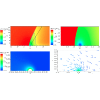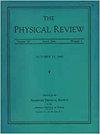Supersonic friction of a black hole traversing a self-interacting scalar dark matter cloud
引用次数: 3
Abstract
Black holes (BHs) traversing a dark matter cloud made out of a self-interacting scalar soliton are slowed down by two complementary effects. At low subsonic speeds, the BH accretes dark matter, and this is the only source of dragging along its motion, if we neglect the backreaction of the cloud's self-gravity. The situation changes at larger supersonic speeds where a shock appears. This leads to the emergence of an additional friction term, associated with the gravitational and scalar pressure interactions and with the wake behind the moving BH. This is a long distance effect that can be captured by the hydrodynamical regime of the scalar flow far away from the BH. This dynamical friction term has the same form as the celebrated Chandrasekhar collisionless result, albeit with a well-defined Coulomb logarithm and a prefactor that is smaller by a factor $2/3$. The infrared cutoff is naturally provided by the size of the scalar cloud, which is set by the scalar mass and coupling, whilst the ultraviolet behavior corresponds to the distance from the BH where the velocity field is significantly perturbed by the BH, which is determined by pressure effects. As a result, supersonic BHs are slowed down by both the accretion drag and the dynamical friction. This effect will be potentially detectable by future gravitational wave experiments as it influences the phase of the gravitational wave signal from inspiralling binaries.

黑洞穿越自相互作用标量暗物质云的超音速摩擦
黑洞(BHs)穿越由自相互作用标量孤子组成的暗物质云时,会被两种互补效应减慢速度。在低亚音速下,黑洞吸积暗物质,如果我们忽略云自身引力的反作用力,这是拖拽黑洞运动的唯一来源。在较大的超音速下,情况发生了变化,此时会出现激波。这导致了一个额外的摩擦项的出现,它与引力和标量压力的相互作用以及移动黑洞后面的尾迹有关。这是一种远距离效应,可以通过远离黑洞的标量流的流体动力学机制来捕捉。这个动态摩擦项与著名的钱德拉塞卡无碰撞结果具有相同的形式,尽管具有定义良好的库仑对数和一个小因子2/3的前因子。红外截止点自然是由标量云的大小提供的,这是由标量质量和耦合决定的,而紫外行为对应于距离黑洞的距离,其中速度场受到黑洞的显著扰动,这是由压力效应决定的。结果,超音速黑洞在吸积阻力和动力摩擦的双重作用下减速。这种效应可能会在未来的引力波实验中被探测到,因为它会影响来自激励双星的引力波信号的相位。
本文章由计算机程序翻译,如有差异,请以英文原文为准。
求助全文
约1分钟内获得全文
求助全文

 求助内容:
求助内容: 应助结果提醒方式:
应助结果提醒方式:


